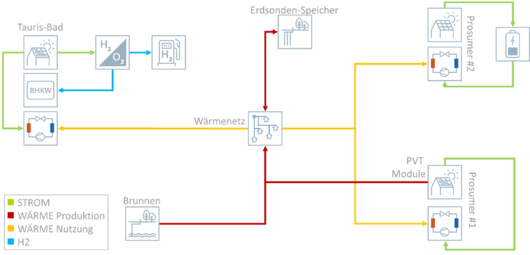Feasibility study "Tauris-Bad" Weißenthurm
The zero-emission quarter
The Tauris leisure pool and surrounding properties will be connected to the cold local heating network in a hybrid renovation plan on account of outdated heating technology and thus partly high temperature requirements: Decentralised heat pumps will heat up to a certain limit temperature depending on the season; in addition, existing natural gas boiler systems and a CHP unit will ensure that the necessary flow temperatures can be reached. The cold network is fed by a reactivated well system with a delivery volume of up to 130 m3/h. In addition, decentralised PVT collectors support the heating network with low temperature. Buffer technologies are possible for peak load periods during the heating season. These are: Ice storage, geothermal probes or air heat exchangers.
With the planned energetic refurbishment of the property buildings, the heat pump percentages and thus the renewable components in the neighbourhood will increase additionally.
Through the joint use of existing energy sources, such as a CHP unit, as well as the use of renewable potential on the site (geothermal system, existing wells, usable solar areas), an improvement in the overall economy is to be expected, while at the same time minimising the CO2 footprint.
Details
As an energy source for the heat pumps, the decommissioned well system should be reactivated as a priority. Other geothermal potentials can be integrated into the heat network in a flexible manner. Solar roof and open space potentials will be developed to provide direct useful energy (solar thermal, photovoltaics) or to serve as an energy source for the heat pumps (e.g. PVT collectors).
Heat requirements with higher temperatures will initially be covered by efficient fossil cogeneration and in the long term will be replaced by purely renewable high-temperature heat sources, such as green hydrogen.
The electricity demand of the neighbourhood is to be covered to a large extent by locally generated photovoltaic and CHP electricity, provided there is simultaneity in time. Electricity storage is possible, but not absolutely necessary in the short term.



